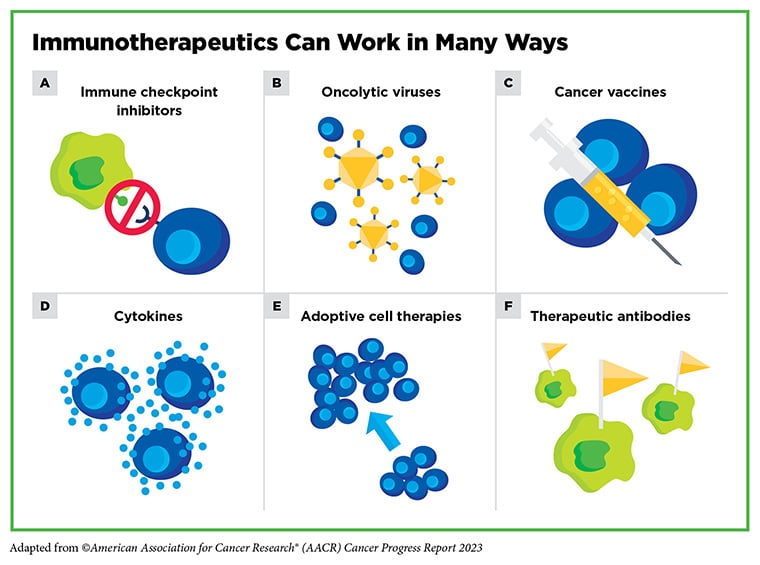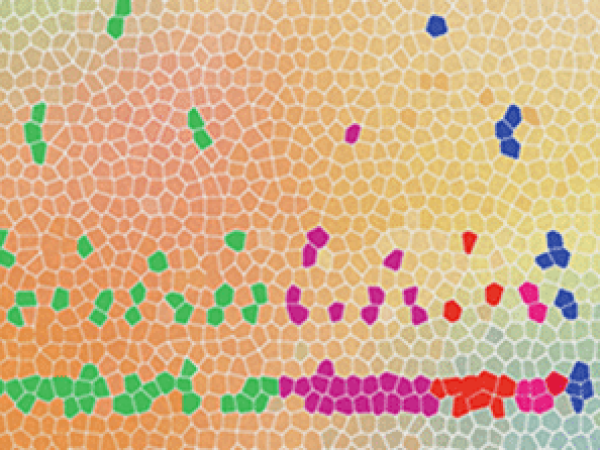What Is Immunotherapy?
Within each of our bodies is a collection of highly regulated cells—called the immune system—capable of recognizing danger, sounding an alarm, and mobilizing to get rid of the threat. The immune system keeps us safe in many ways: by clearing infections, healing wounds, and, yes, even fighting cancer.
Cancers, however, have many tricks to escape the immune system. Fortunately, researchers are discovering innovative strategies to intervene and enable immune cells to do their job. These strategies form the basis of cancer immunotherapy, a revolutionary class of cancer treatment that uses, enhances, or modifies a patient’s own immune system to fight cancer.
Types of cancer immunotherapy include: immune checkpoint inhibitors, adoptive cell therapy (ACT), bispecific T-cell engagers (BiTEs), therapeutic vaccines, oncolytic viruses, and cytokines.
What are Immune Checkpoint Inhibitors?
To prevent the immune system from becoming overactive and harming tissue in vital organs, immune cells are naturally equipped with “brakes” that turn off immune activity when no longer needed. Many cancer cells can hijack this safeguard and use it for their own benefit—keeping immune cells “off” so they can’t attack and kill cancer cells.
To counter this effect, drugs called immune checkpoint inhibitors release the “brakes” on immune activity, allowing immune cells to destroy cancer cells. The U.S. Food and Drug Administration (FDA) has approved immune checkpoint inhibitors to treat several types of cancer.
What is Adoptive Cell Therapy?
ACT boosts the natural ability of the patient’s immune cells to fight cancer. For ACT, the patient’s own immune cells are isolated from their body, grown in a lab to dramatically increase their number, and then given back to the patient to seek and destroy cancer cells. There are three different classes of ACT.
CAR T-cell Therapy
Chimeric antigen receptor (CAR) T-cell therapy is one class of ACT in which a patient’s T cells (a type of immune cell) are isolated from blood and genetically modified to make a protein called CAR that recognizes cancer cells. The modified T cells are then infused back into the patient where they will seek out and kill cancer cells. The FDA has approved CAR T-cell therapy for many blood cancers, but it has so far been ineffective against solid tumors.
TCR T-cell Therapy
Another type of ACT is T-cell receptor (TCR) therapy. In this treatment, T cells from a patient’s blood are genetically modified in the laboratory to make a protein called TCR before being infused back into the patient. The TCR protein helps the T cells seek out the patient’s cancer cells more effectively and triggers them to attack the patient’s cancer cells.
TIL Therapy
A third type of ACT, called tumor-infiltrating lymphocyte (TIL) therapy, uses T cells that have already made their way into tumors; these T cells are referred to as tumor-infiltrating lymphocytes (TILs).
For TIL therapy, part of the patient’s tumor is surgically removed, and the TILs from within it are isolated, grown in the lab, and delivered back to the patient. Unlike the other types of ACT, TIL therapy does not require genetic modification of the patient’s immune cells. TIL therapy is approved to treat certain melanomas.

What are BiTEs?
An immune cell must find a cancer cell before it can attack and eliminate it. Specialized proteins called antibodies help immune cells find their targets, whether that be a virus, bacterium, or cancer cell. Researchers have developed antibodies for cancer therapy that can better help immune cells find cancer cells.
An immunotherapy known as a BiTE is essentially a two-headed antibody that can bind to two different proteins at the same time—one protein on immune cells and another on cancer cells. By simultaneously binding proteins on both cell types, BiTEs bring immune cells near cancer cells so they can eliminate the cancer cells. BiTEs are approved for a variety of blood cancers, as well as for lung cancer.
What are Therapeutic Vaccines?
Generally speaking, vaccines train the immune system to recognize and fight disease. Some vaccines, like the HPV vaccine, can prevent cancer, but the therapeutic vaccines developed as cancer immunotherapy are used to treat patients who already have cancer.
Therapeutic vaccines work by exposing the patient’s immune system to a protein made by cancer cells. Once the patient’s immune cells are trained to recognize the cancer-associated protein, they will be able to find and kill cancer cells throughout the patient’s body. A therapeutic vaccine is approved to treat prostate cancer.
What are Oncolytic Viruses?
Oncolytic viruses exploit the natural ability of some viruses to infect cancer cells. These modified viruses do not cause infectious disease but are able to kill cancer cells. Molecules released from the dying cancer cells further boost the immune response against cancer. This type of immunotherapy is approved for melanoma.
What are Cytokines?
Immune cells release molecules called cytokines to rapidly activate the immune system to respond to infection or cancer. When given to patients, cytokines can boost their immune system against cancer, improve the efficacy of other immunotherapies, or help mitigate some side effects.
Ongoing Immunotherapy Research
Researchers continue to explore ways to improve immunotherapy: combining immunotherapies with one another and with other cancer treatments, mitigating side effects, increasing access to immunotherapy in underserved areas, and predicting which patients might benefit most from immunotherapy.
The American Association for Cancer Research (AACR) supports these research efforts and others through several avenues, including its grants, publications, and scientific meetings. Next year’s inaugural AACR IO conference will convene renowned cancer immunotherapy pioneers to discuss exciting new directions in immunotherapy research.



